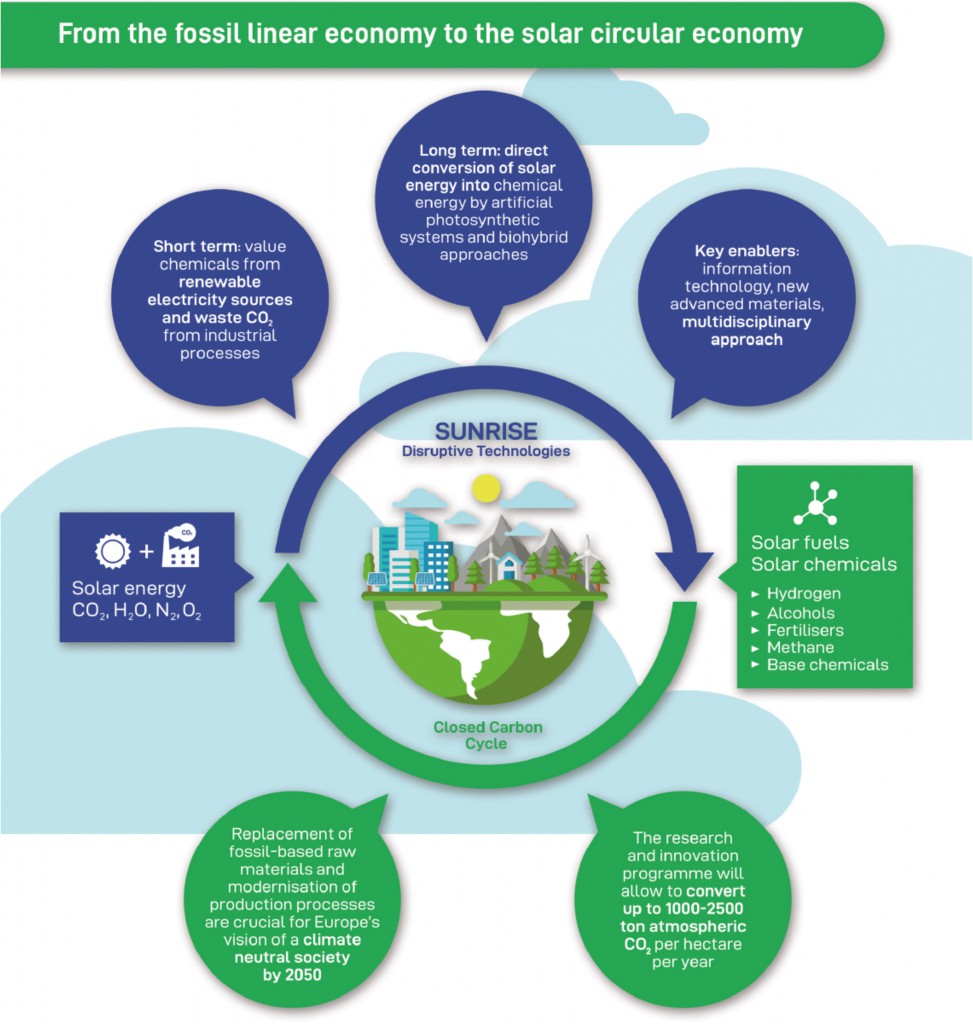From fossil to renewable fuels: Interview with Hélène Lepaumier
Leiden University SUNRISE project aim at a circular production of high-value chemicals using renewable electricity sources and waste carbon dioxide from industrial processes
When asked about the future of the sustainable energy, Hélène Lepaumier is optimistic: “Moving away from the use of fossil fuels will be a long process, but it is definitely feasible if we have cheap and abundant energy to produce these renewable fuels.”
During the SUNRISE consortium meeting held in May in Bologna (Italy), we had the chance to interview our partner Hélène Lepaumier. As a research engineer at ENGIE Laborelec, Hélène is an expert in carbon capture -emission monitoring, CO2 quality, environmental impact- and carbon use.
Watch this insightful interview and grasp more about the link between neutral climate and renewable fuels. This is the second of a series of video interviews with SUNRISE experts. Stay tuned to our website and social media channels – there are still more to come!
Interested in grasping more about circular economy? You can also see the first of our view interviews’ series with our partner Nicola Armaroli, research director at the National Research Council of Italy (CNR)!
About SUNRISE
Our goal is to provide a sustainable alternative to the fossil-based, energy-intensive production of fuels and base chemicals. The needed energy will be provided by sunlight, the raw materials will be molecules abundantly available in the atmosphere, such as carbon dioxide, oxygen and nitrogen.
SUNRISE’s ambition is to convert up to 2500 tons of CO2 and to produce more than 100 tons of commodity chemicals per hectare per year, realizing a 300% energy gain over present best practices and deploying devices on the 1000 hectare scale by 2030. This requires new materials for absorbing more than 90% of light and storing more than 80% of the photogenerated electrons in fuels or chemicals. With its unconventional approaches, SUNRISE will overcome the critical hurdle of the conversion of atmospheric CO2, so far a distant promise. Over its running span of 10 years, from 2020 to 2030, the flagship aims to:
- Reach an operational production cost level of 0.4 €/L for fuel with competitive manufacturing of key enabling technologies.
- Bring atmospheric CO2 photoconversion to the prototype level in operational environments.

Short term
In the short-to-medium term, we primarily aim at a circular production of high-value chemicals using renewable electricity sources and waste carbon dioxide from industrial processes. Existing technologies with relatively high technology-readiness-levels have to be optimized regarding their efficiency, sustainability and up-scalability to industrial level. Taking the example of water electrolysis driven by renewable electricity to produce hydrogen, more efficient catalyst materials are urgently needed to make this technology a true alternative. In the medium term, devices based on photoelectro-catalysis permit to skip the primary step of electricity production through e.g. photovoltaic cells by converting solar energy, hydrogen and concentrated carbon dioxide directly into chemical products.
Long term
In the long term, the energy input for the chemical processes is provided by sunlight, which is directly converted into chemical products. Radically new approaches (based e.g. on photochemistry, electrochemistry or biology) allow to transform dilute carbon dioxide, nitrogen or oxygen from the atmosphere into chemical compounds, mimicking natural photosynthesis. This artificial leaf approach finally targets sustainable high-value chemicals that can be concentrated to any desired level, going beyond the natural photosynthesis process with higher efficiency and a wide selection of target molecules.
Key enablers
Key enablers for such an ambitious transition are information technology and new advanced materials. The former will enable optimized production processes, with savings of energy and feedstocks. New materials will allow cost-competitive, efficient and durable solutions across a number of renewable energy technologies. Given the interdisciplinary character of solar energy research and its intrinsic societal and economic implications, this flagship initiative requires key contributions from a wide spectrum of disciplines, including chemistry, biology, physics and engineering as well as social and environmental sciences and humanities.
Source: SUNRISE project, press release, 2019-11-04.
